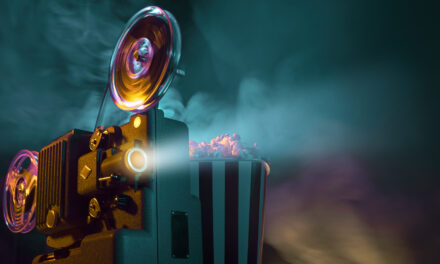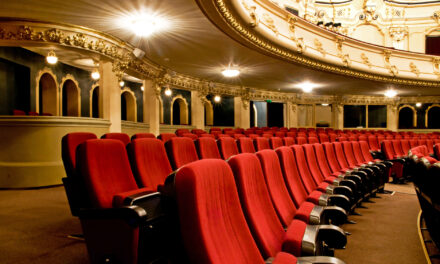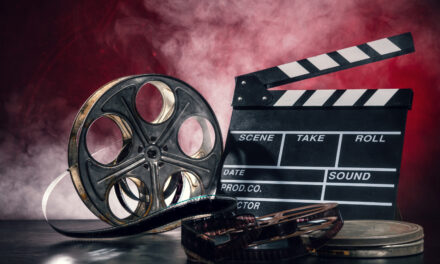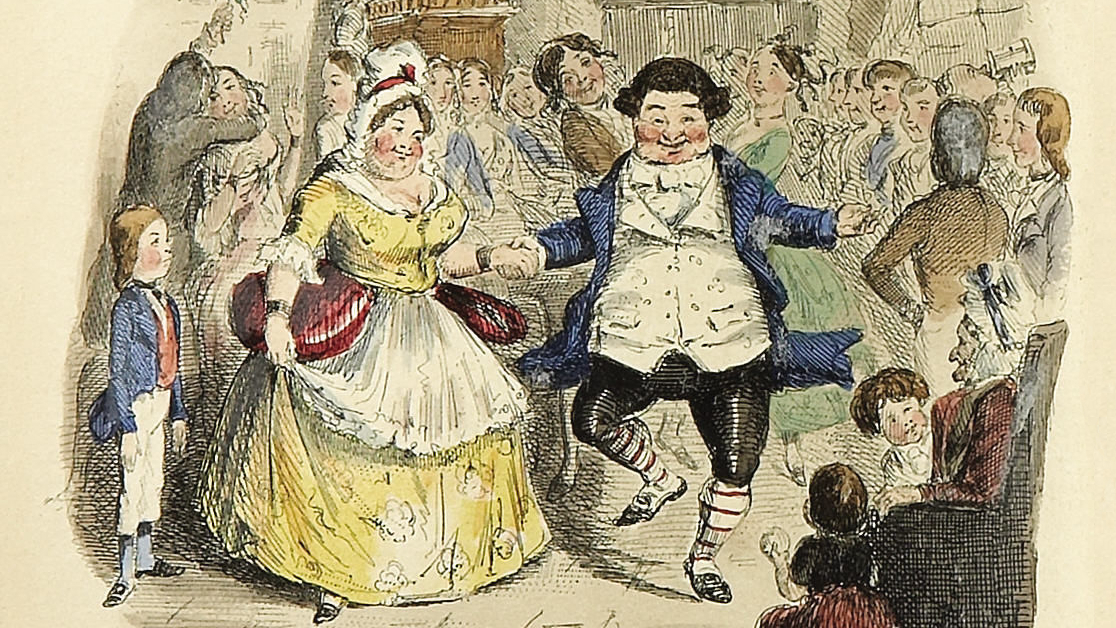
The Best ‘Christmas Carol’ Movie Versions
Charles Dickens’s classic holiday story, A Christmas Carol, has been warming hearts and promoting the spirit of charitable goodwill since it was first published a few days before Christmas in 1843. In telling the tale of Ebenezer Scrooge’s transformation from a misanthropic miser to a man filled with the joy and generosity of Christmas, Dickens created a timeless masterpiece that has lived on and become as much a part of the holiday as the Christmas tree that had been introduced in Dickens’s England only two years before.

The first edition of Charles Dickens's book A Christmas Carol (1843), with illustrations by John Leech. (Public domain, via Wikimedia Commons)
A Christmas Carol was a great popular and critical success. It was adapted for the theater within months of publication. From 1853 until his death in 1870, Dickens presented dozens of public readings of A Christmas Carol, which were immensely popular.
Since then, there have been countless adaptations of the story for the stage, radio, movies, television—even an opera and one or two graphic novels. Some of these adaptations were more faithful to Dickens’s original story than others, and some were, of course, more popular and successful than others.
This article spotlights the best Christmas Carol movie versions in chronological order. Each is a holiday classic in its own right. You can’t go wrong with any one of them.
'A Christmas Carol' (1938) Starring Reginald Owen
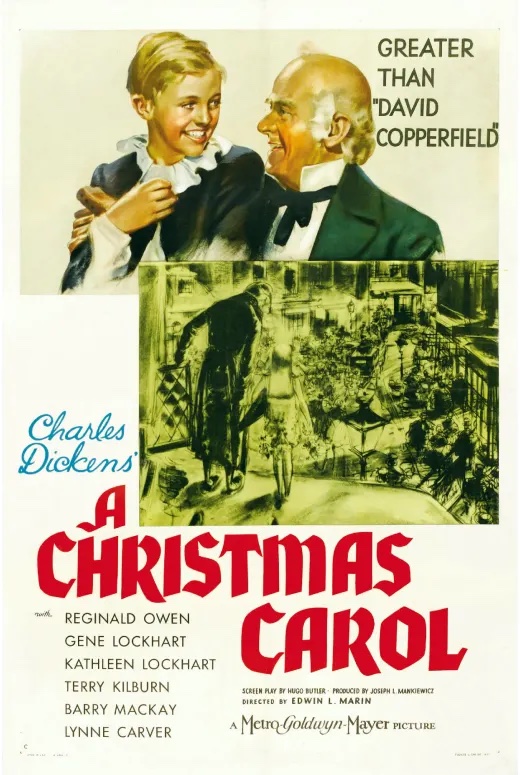
Poster for the 1938 film A Christmas Carol starring Reginald Owen. (MGM, Public domain, via Wikimedia Commons)
This lavish MGM production was the definitive movie version of A Christmas Carol for more than a decade, and many people still consider it their favorite. The movie faithfully recreates Dickens’s London of the 1840s, and Reginald Owen’s portrayal of Scrooge strikes the right notes both before and after his transformation. Barry MacKay and Gene Lockhart are terrific as Scrooge’s joyful nephew Fred and his long-suffering clerk Bob Cratchit, respectively, while Leo G. Carroll is memorable as Marley’s Ghost.
This version downplays the spookiness of the visits by the three Christmas spirits and omits several significant details of Scrooge’s past, including the party given by his employer Mr. Fezziwig and his engagement to Belle. It also adds scenes to the story: for example, Scrooge fires Bob Cratchit on Christmas Eve when Bob accidentally hits him with a snowball, and Scrooge calls three watchmen to his room to deal with Marley’s ghost. But the overall look and feel of the movie are certifiably Dickensian, and the movie’s infectious Christmas spirit is hard to resist.
'A Christmas Carol' (1951) Starring Alastair Sim
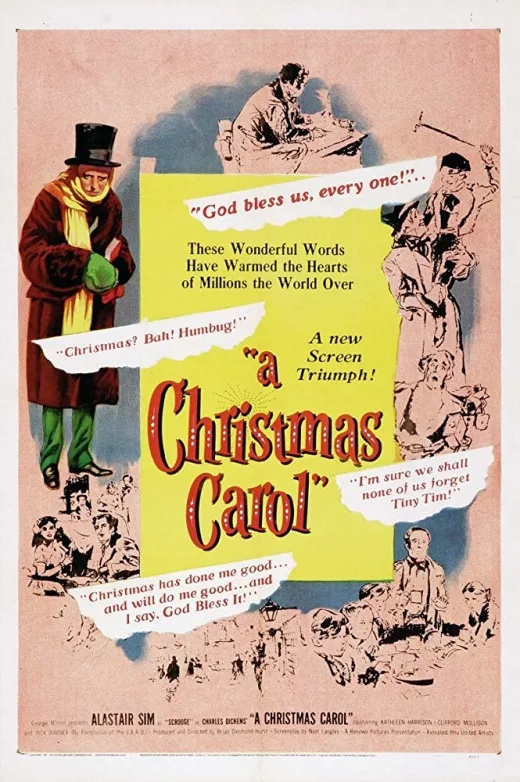
Poster for the 1951 movie A Christmas Carol starring Alastair Sim. (IMDb)
This English production was first released in the U.K. as Scrooge, but the U.S. distributor, United Artists, released it in the United States under the title A Christmas Carol. The initial reviews were mixed, and the movie did not do particularly well at the box office.
In 1954, the movie debuted on television in New York, and for many years it alternated with the 1938 version on local New York TV. By the 1970s it had become a popular favorite and is now considered a classic.
Alastair Sim’s acclaimed portrayal of Scrooge anchors the film; for many people, Sim is Ebenezer Scrooge. He is equally believable as the miserable, cold-hearted businessman of the opening scenes and the regenerated benevolent employer and uncle that he becomes by the end of the story. Another key role is played by Kathleen Harrison as Mrs. Dilber, Scrooge’s charwoman, whose presence in the story is greatly expanded.
The film is faithful to Dickens’s original story but adds some storylines to the account of Scrooge’s early life that are meant to shed light on his single-minded and ruthless pursuit of business and the nature of his relationship with his nephew Fred.
This version of A Christmas Carol is the classic one against which all others are measured and is a must-see.
'Scrooge' (1970) Starring Albert Finney

Movie poster for the 1970 movie musical Scrooge starring Albert Finney. (IMDb)
The production of this musical version of A Christmas Carol was prompted by the success of Oliver, 1968’s Academy Award-winning adaptation of Dickens’s Oliver Twist.
Scrooge likewise won acclaim, receiving a nomination for a BAFTA film award in the U.K., four Oscar nominations, and five Golden Globe award nominations. Albert Finney’s wonderful performance as Ebenezer Scrooge was recognized with a Golden Globe award for Best Actor – Motion Picture Musical or Comedy.
As a musical, Scrooge not surprisingly deviates from Dickens’s original story at many points in order to set up the song and dance numbers throughout the film. One especially noteworthy invented scene occurs when Scrooge falls into his grave as he is visiting it with the Ghost of Christmas Yet to Come. He arrives in hell and meets Jacob Marley, who tells him that he is to become Lucifer’s clerk.
The 34-year-old Finney does a masterful job of portraying Scrooge at all stages of his life, both before and after his redemption. Alec Guinness is memorable as Marley’s Ghost. And the streets of London are themselves a character, as they come alive in many scenes throughout the movie.
The movie contains a number of catchy and memorable songs, including “Thank You Very Much,” which was nominated for an Academy Award as Best Original Song.
'A Christmas Carol' (1984) Starring George C. Scott

Poster for the 1984 TV movie A Christmas Carol starring George C. Scott. (IMDb)
This made-for-television movie version of A Christmas Carol, starring George C. Scott, was shot in England and directed by Clive Donner, one of the film editors of the 1951 version. The movie was released theatrically in Great Britain but shown on the CBS television network in the United States.
It was very well received by critics and the public alike, and many now consider it to be the definitive version of A Christmas Carol, with Scott as the quintessential Ebenezer Scrooge. Scott received an Emmy nomination for Outstanding Lead Actor In A Limited Series Or A Special.
The film is very true to Dickens, with few of his scenes omitted and only a handful of new scenes added. Except for the fact that the Ghost of Christmas Past is a woman, the three spirits are faithful recreations of the ghosts as described by Dickens.
Scott does an especially good job of conveying the loneliness that has led Scrooge to become the isolated miser that he is at the outset of the story. Despite the many interpretations of Scrooge that came before, Scott makes Scrooge his own in this acclaimed version of A Christmas Carol.
'The Muppet Christmas Carol' (1992) Starring Michael Caine
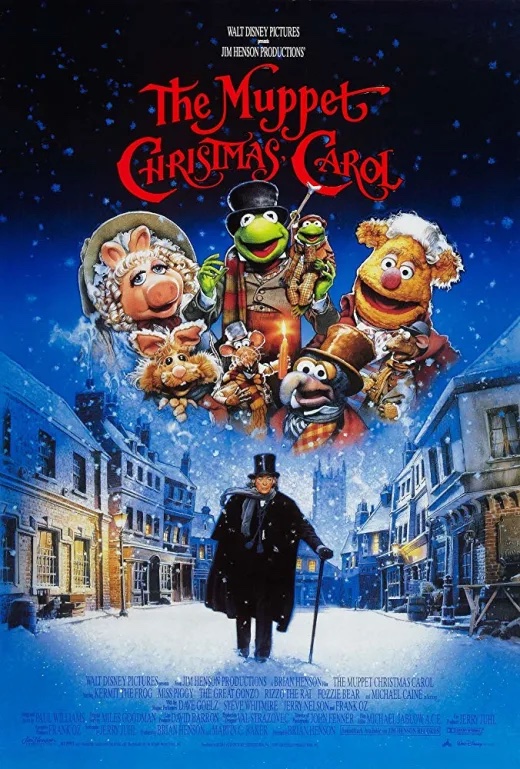
Poster for 1992 movie The Muppet Christmas Carol starring Michael Caine. (IMDb)
This unique comic adaptation of A Christmas Carol combines human actors, most notably Michael Caine as a wonderful Ebenezer Scrooge, with Jim Henson’s Muppets. Kermit the Frog is Bob Cratchit, Miss Piggy is Mrs. Cratchit, and Robin the Frog plays Tiny Tim. Charles Dickens himself, played by Muppet Gonzo the Great, appears in the movie as the narrator, accompanied by Rizzo the Rat, with lots of slapstick humor and comic banter between the two.
Surprisingly, given the cast, the movie is quite faithful to Dickens’s original story. Much of the narration and dialogue is in Dickens’s own words. The three ghosts, although played by Muppets, appear more or less as Dickens described them. The movie does add a second Marley, Jacob’s brother Robert, to make room for the old-man Muppets Statler and Waldorf with their trademark humor. And Fezziwig is now “Fozziwig,” appropriately played by Fozzie Bear.
The actors, both human and Muppet, give very good performances. Caine is especially good at making his interactions with the Muppet characters look completely natural. Though it is undeniably different from the other primary movie and TV versions of the story, this adaptation is exceptionally entertaining and fun for the whole family.
'A Christmas Carol' (1999) Starring Patrick Stewart
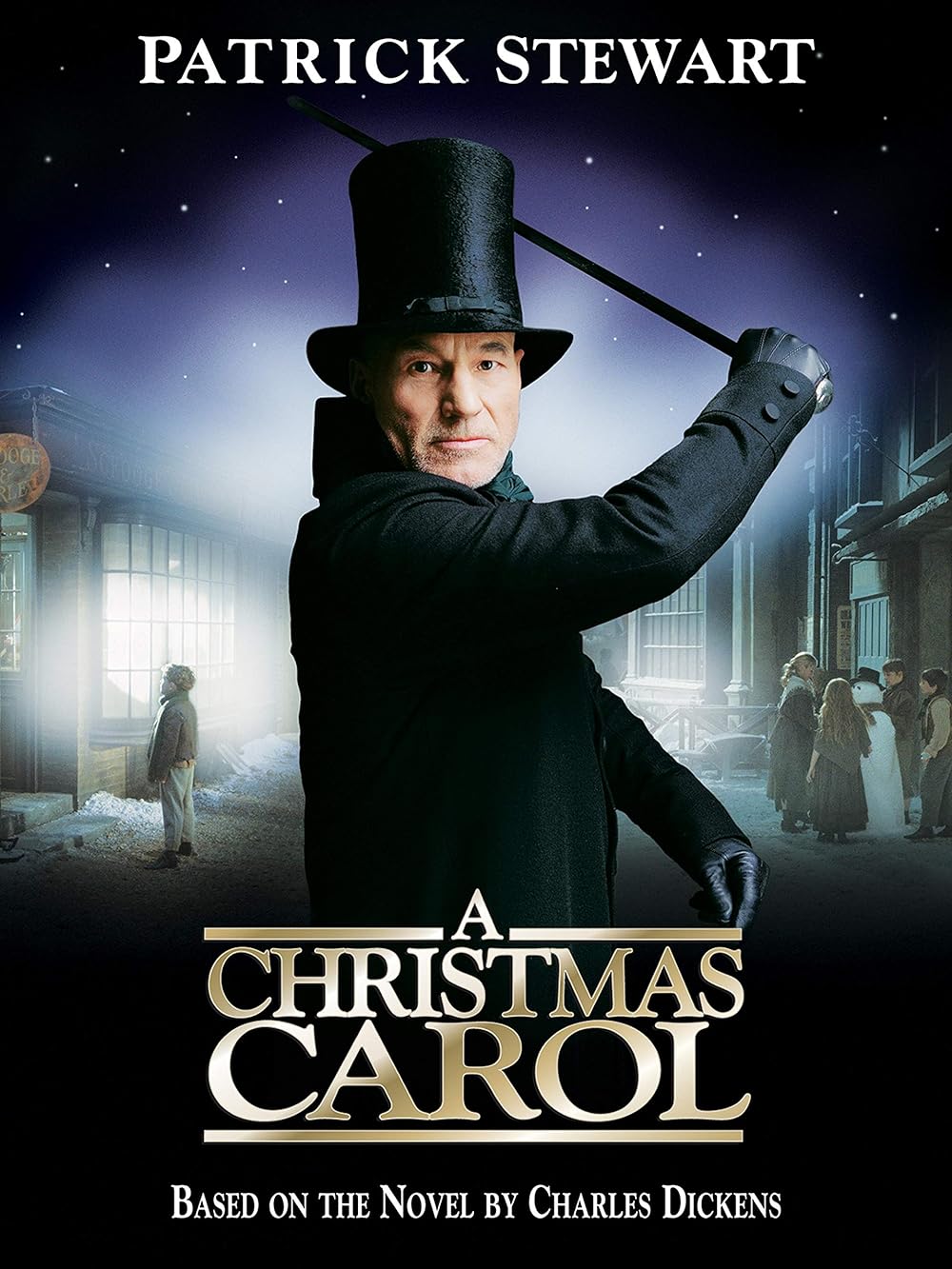
Poster for the 1999 version of A Christmas Carol starring Patrick Stewart. (IMDb)
Although Patrick Stewart is best known for his role as Captain Jean-Luc Picard in Star Trek, he trained as a Shakespearean actor. Stewart staged numerous one-man dramatic readings of A Christmas Carol in London and on Broadway. Turner Network Television (TNT) built this version of the story around his acclaimed performances. Stewart’s portrayal of Scrooge has been generally acknowledged to be excellent, and the film contains other outstanding performances as well, including that of Joel Gray as the Ghost of Christmas Past.
This version of A Christmas Carol is a very faithful adaptation of Dickens’s original story, with few of Dickens’s scenes left out and few new scenes inserted that were not in the novella. The film makes good use of special effects, mostly to add visual flair to Dickens’s “ghost story”: For example, Scrooge sees Marley’s face reflected in the fireplace tiles, and Marley’s jaw drops inhumanly far when his head wrapping is removed. At the end of his journey with the Ghost of Christmas Yet to Come, Scrooge not only sees his grave but falls into it and is transported through time back to his own bed.
If you are looking for a modern cinematic treatment of the classic story that remains close to Dickens’s original, this 1999 version is hard to beat.
Disney's 'A Christmas Carol' (2009) Starring Jim Carrey
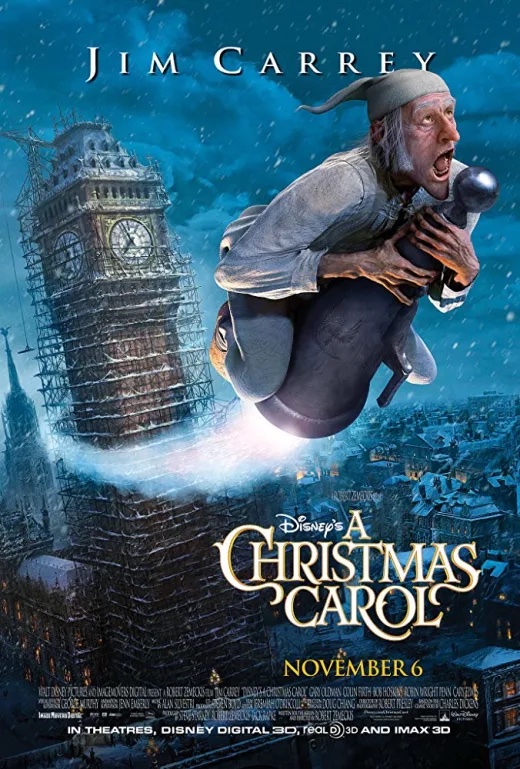
Poster for the 2009 movie Disney’s A Christmas Carol starring Jim Carrey. (IMDb)
Director Robert Zemeckis filmed this digital 3-D version of A Christmas Carol using the performance capture process that he had used previously for The Polar Express. The film successfully recreates many of the details of Dickens’s London of the 1840s and features stunning and scary special effects that brilliantly bring to life the imaginative ghost story that Dickens created.
Jim Carrey plays multiple roles, including Ebenezer Scrooge at various ages and all three of the Christmas ghosts who come to haunt him. Other actors play multiple characters too, including Gary Oldman (Bob Cratchit, Jacob Marley, and Tiny Tim), Robin Wright Penn (Fan, Belle), and Bob Hoskins (Fezziwig, Old Joe). Carrey and most of the other actors (or their digital selves) give excellent performances.
The movie adds some humorous touches that were not in Dickens’s book but are generally consistent with the spirit of the original story. Best of all are the unique visuals—it’s a new, 21st-century look for this timeless 19th-century story.
Some Other Notable Versions of 'A Christmas Carol'
These adaptations of Dickens’s classic are far from the only ones. Other versions worth seeing include the 1935 British movie Scrooge, starring Seymour Hicks as Ebenezer Scrooge, and the 1954 A Christmas Carol made for American TV, starring Frederic March as Scrooge and Basil Rathbone as Marley.
A hilarious modern take on Dickens’s story is the 1988 movie Scrooged, starring Bill Murray as Frank Cross, a successful television executive whose ambition has warped his character and driven away the woman he loved. When he fires an employee on Christmas Eve, Frank receives visits from three ghosts who offer him a chance at redemption.
And no list of movie and TV versions of A Christmas Carol would be complete without mentioning some of the numerous animated adaptations of the story. Over the years, Ebenezer Scrooge has been played by many famous cartoon characters, including Scrooge McDuck in Mickey’s Christmas Carol (1983 short film) and Fred Flintstone in A Flintstones Christmas Carol (1994 television special). Another favorite is Mr. Magoo’s Christmas Carol (1962), which was the first animated TV Christmas special.
God Bless Us, Every One!
For many people, no Christmas season is complete without at least one viewing of A Christmas Carol. Dickens’s little “ghost story” is as inspirational and as fun as ever.
There are lots of great performances to choose from. Enjoy!
Copyright © Brian Lokker 2018, 2023. An earlier version of this article was published on HubPages.com in 2018 and was subsequently featured on ReelRundown.com.

